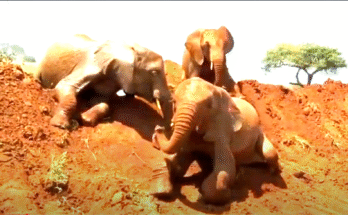In the quiet countryside where sugarcane fields stretch for miles, the rhythm of daily life is often interrupted by an unexpected visitor. A massive wild elephant, known among locals for its bold behavior, has developed a peculiar habit—stopping passing trucks to steal sugarcane. Drivers along the rural highway have grown accustomed to slowing down whenever the giant emerges from the trees, blocking the road with its towering frame.
The scene is both amusing and alarming. The elephant approaches the vehicles with surprising intelligence, using its trunk to tap on the truck until the driver halts. Once stopped, it wastes no time in reaching inside, pulling out bundles of freshly harvested sugarcane. With a loud crunch, the elephant chews happily, unconcerned about the delay it causes. Many drivers, aware of the animal’s strength, surrender part of their cargo rather than risk confrontation.
Villagers often gather nearby to watch the spectacle, their laughter echoing as the greedy elephant enjoys its stolen feast. Some even record the encounters on their phones, turning the mischievous act into a source of viral entertainment. Yet, beneath the humor lies a growing concern. The elephant’s behavior reflects how wildlife adapts to human activity, sometimes in dangerous ways. Trucks can be damaged, drivers may be injured, and the elephant itself risks accidents on the busy road.
Local authorities have begun discussing measures to address the situation—perhaps creating safe feeding zones away from the highway, or finding ways to guide the elephant back into the forest. Until then, truck drivers continue to share their sugarcane with the persistent giant, a reminder of how man and nature often collide in unexpected and unforgettable encounters.


